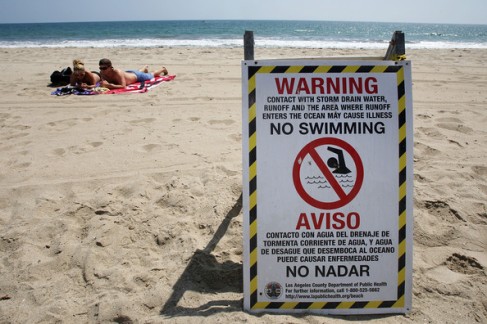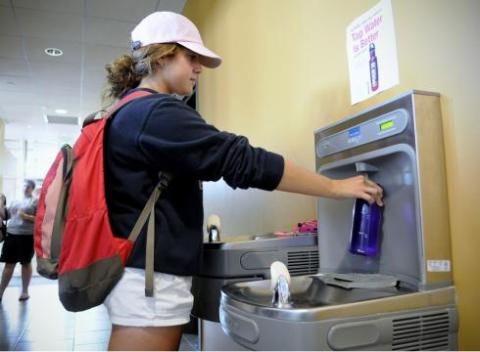With the upcoming presidential election, politics is one of the hottest topics around. While we owe it to ourselves to be educated on the issues and to go out and vote in November, it is also imperative that we pay attention to local, state and regional issues, especially those affecting the environment. The clamor over immigration issues, health care and “Fast and Furious” was so loud this past week that it practically drowned out the enactment of several “green” laws that took effect on July 1st.
Noting that “the abundance of aquatic life is one measure of a healthy Chesapeake Bay“, several laws taking affect over the weekend are aimed at significantly reducing pollution from varying sources. Laws passed to protect the Chesapeake Bay include:
- Doubling the flush tax from $2.50 to $5.00 to raise funds to upgrade wastewater treatment plants.
- Placement of limitations on areas where developers can build residential communities that use septic tanks.
- Requiring local jurisdictions to set fees to fight storm water pollution in Baltimore City and nine of the largest counties in Maryland.
These green laws are a manifestation of the need to accomplish eco-friendly objectives through taxation as there clearly has been a failure to achieve the desired results through advertising, education and voluntary public support. The green movement has been around for a long time, yet most citizens have not jumped on the bandwagon. In future legislation, we can expect to see further taxes to reduce waste and increase recycling in the form of taxes on grocery bags and more bottle deposits.
No one likes the idea of higher taxes, but “green” taxes are an inevitable component of improving the environment and failure to act voluntarily serves as a mandate for government to enact and enforce policies to guarantee the protection of the environment. In an effort to lower our taxes, let’s voluntarily live green, be green!
Earlier today, the Supreme Court submitted its ruling that upholds the constitutionality of the Affordable Health Care Act or as we have come to know it, “Obamacare”. The overall costs of this act in terms of dollars will be hotly debated for years to come, especially in regards to individual mandates and expansion of Medicaid to cover unemployed and uninsured people. While there is some disagreement about some of the terms of Obamacare, one positive lies in the mandatory provision of preventive services, especially for women and children. This definitely fits into the category of a green initiative.
With this provision, many people, young and old,will get the opportunity to get medical services in a physician’s office rather than in the emergency room. This experience is important because an established doctor-patient relationship in an office carries with it an educational component. People with established relationships with medical professionals can attest to the availability of reading material available in the doctor’s waiting rooms regarding nutrition, exercise, hygiene, etc., as well as the videos that often are playing on the televisions. The wait time in the physician’s office is a dedicated learning experience. Also, the scheduled block of time for each patient provides opportunities to ask the physician or the assistants general health questions and to get referrals for ancillary services, such as counseling, support groups, etc. On the other hand, appearances in area hospital emergency rooms are often rushed due to the sheer number of people waiting to be seen.
Preventive services are very important because they incorporate a holistic approach to good health. They encourage us to make the connection between positive changes afforded by clean air, clean water, healthy diet, environmental changes and other green initiatives that help us to avoid health problems.
We also can expect to see hospitals and medical practices adopt practices to control the increased flow of visitors to their facilities. These initiatives include the increased use of visiting nurse practitioners and physicians to homes to treat chronically ill patients, the use of computers and video conferencing to maintain remote contact with patients to discuss their conditions and the introduction of more community counseling, lecture series and classes for patients to address health issues.
Obamacare definitely is a step in the right direction to educating citizens to live green, be green!
Summertime is here, and the beach is the number one destination for many vacations. Sadly, many of the beaches in the United States are polluted by storm water runoff and sewage. Moreover, a study by the National Resources Defense Council indicates that 15 of the beaches cited in 2012 have had “water samples violating public health standards more than 25% of the time” every year from 2007 to 2011. Over the past few years, the United States has been plagued by severe storms that create storm water runoff; however, the problem with pollution at more than 3000 beaches in this country has been defined by animal and human waste. It is so important that we put in place and observe green initiatives to protect our beaches so that vacations on the water can remain carefree. Green beaches translate to green economy for so many areas of this country that are dependent on the dollars earned from tourists and vacationers.
The goal to clean up beaches is not an impossible one as evidenced by the state of beaches in Great Britain, where quality of bathing waters has improved significantly over the past 20 years. This was accomplished largely by upgrading sewage overflow infrastructures, thereby reducing the amount of sewage overflow to surrounding waters. The increase in populations alone all over the country mandate the upgrades of water flow systems to meet the added use demands. Consistent and frequent monitoring of water quality through sampling is of utmost importance. Relaying the results of water quality samples serves to engage the green public to take action to support these environmental green initiatives.
Green beaches are important to our world because they protect sea life— plants and fish. They are a source of relaxation and fun for all citizens, and they are vital to the economies of so many communities.
Let’s green up our beaches to live green, be green!
Source: David McNew/Getty Images North America)
I read an opinion piece earlier today by Columbia University faculty member, Steven Cohen, entitled The Transition to a Sustainable Economy May Happen Without the U.S. Federal Government. Several strong and sometimes witty points are addressed in the article, all of which are of reasonable importance. Overall, however, the piece points out the ever-increasing need for further developments in the realm of environmentally conscious change, through not only personal choices of society members, but through official government policies. The latter of which, we have surprisingly found to be almost entirely lacking in the U.S., despite further research on the matters that may very well affect the future.
One highlight of the piece that I do consider to be one of the more important elements, is a referenced letter from the co-CEO’s of Kohlberg Kravis Roberts (KKR), a major global investment firm. Although working predominantly within the financial industry, even KKR and its leaders strongly believe in higher levels of sustainability practices. Among other things, they mention that such initiatives will lead to a better use of resources, as well as a more profitable business. It is essentially a win-win situation, so long as adequate effort is put into it.
A major distaste for the U.S. government’s lack of response to trending issues on limited resources and needed sustainability is openly expressed by Cohen as well. To be honest, he is rightfully disappointed. However, as I continued to read on and hop around the Huffington Post website, I did come across a slideshow list of the Greenest Celebrities. I usually find such things hard to stomach, but in this case, I was immediately drawn in. Some of the members of the list came as no surprise, but others I found to be quite the opposite. I think its worth checking out and reading up on each of the celebs, but no matter how you view the issues, it can give a little more hope to the cause – although government officials seemingly refuse to take steps forward, perhaps with high profile individuals like celebrities pushing for advancement and programs, the green movement has large-scale hope yet.
Today’s young think tanks, also known as universities, are the center of movements of equality, and more recently sustainability. Recently, over 90 colleges and universities have taken upon themselves to limit the use of plastic bottles on campus. While some colleges such as Yale and Cornell have banned the use of plastic bottles outright, others are in the midst of turning their campuses into models of efficiency and sustainability.
These schools have thus replaced the old mosaic of purchasing water bottles with hydration stations, which are placed strategically around their respective campuses, and provide free filtered water. In addition, incoming freshman are given free aluminum bottles at student orientation to promote the use of this sustainable feature.
While some fear the ban of plastics will actually promote the consumption of sugary substitutes, the truth of the matter is that as long as students do not have to go out of their way to re-hydrate, and it is of no cost to them, the hydration stations will be a success. Anytime you can promote the idea of sustainability you should. And anytime this ideal crosses paths with consumerism driven and educated twenty-something-year-olds there is bound to be success. Whether or not we like it, college students drive a tremendous amount of demand for goods and services, and whose opinions matter significantly to marketers. As a recently graduated college student, I am proud to see that the opinions of young people are beginning to focus more and more about sustainability and the green movement rather than Snooki and JWow. Together we can strive to live green, and be green while making socially responsible decisions.
TED is amazing in taking a
Eco-fashion is a term that denotes the commitment of designers to produce and promote the use of sustainable, ethical and environmentally-conscious products. The term is contemporary; however, a green relationship between fashion designers and environmentalists has existed for centuries.
The major concerns of green fashion are the following:
- Recycling of materials
- Origin of material (fair trade concerns)
- Textile dying and production
- Quality of craftmanship
- Fair labor practices
- Humane treatment of animals
Eco-fashion has evolved further to include reducing consumption and recognizing the need to be stylish while being fashionably green. This movement focuses on centering a wardrobe around the basics, i.e., the little black dress or basic suit, and then accessorizing with scarves, jewelry and shoes to transition a look for different periods of the day or various events. Magazines, television shows, You Tube videos now feature helpful money-saving and style-enhancing techniques to look nice and be green. Also, there are several books available on the market that provide great tips on everyday and specialty and seasonal dressing, all accomplished in a tasteful, frugal and green manner. An excellent place to start is with Katy Tsui‘s blog on the Huffington Post at http://www.huffingtonpost.com/kaity-tsui/10-fashion-resources_b_1609629.html?utm_hp_ref=stylelist&ir=Stylelist. Katy provides great multimedia references on the subject of fashion. Her dialogue on green responsibility is refreshing in its simplicity.
There are so many ways to go green, and eco-fashion is a fun way to get involved.
Let’s dress green, go green, be green!
The first day of summer marks the beginning of the annual celebration of Pollinator Week. During this week, the Pollinator Partnership, conservation and pollination supporters, recognize the contributions to green initiatives made by pollinating animals and insects. The Pollinator Partnership is a 501(3)(c) non-profit corporation dedicated to the good health, protection and conversation of all pollinating animals and insects, including, but not limited to bees, butterflies, moths, beetles, hummingbirds and bats. These green “warriors” support the production of food and the health of the ecosystem.
Research results by the Pollinator Partnership give an impressive breakdown of the contributions of pollinators. (1) Between 75% and 95% of all plants on the earth rely on pollinators for their survival. (2) Pollinators service approximately 180,000 different plant species and more than 1200 crops. (3) Approximately 33% of the food consumed is available because of pollinators. (4) In economic terms, pollinators generate $217 billion to the global economy, and the “green” work of honey bees is responsible for up to $5.4 billion to the U.S. agricultural production alone. (5) Pollination supports green initiatives by cleaning the air, stabilizing the soil and supporting other wildlife.
The Pollination Partnership offers a Planting Guide that can be used with an interactive database of 1,000 native plants. Green gardeners can select plants according to the pollinators they wish to attract and determine the necessary light, soil requirements, plant types and bloom colors for their gardens. With this guide, plant enthusiasts can have the garden they desire while simultaneously supporting pollinators and green initiatives.
Let’s pollinate green, live green, be green.
The Community Pollination Project (photo credit: Landcare Research, Mankaai Whenua Research Organization)



